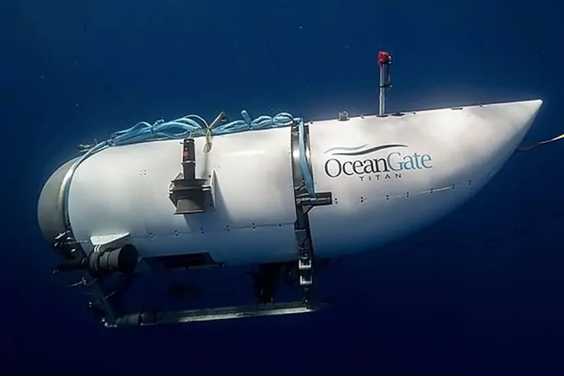
By Ahmed Saeed
Owing to the inherent risks involved, submarine service is generally perceived to be unsafe. However, keeping in view the stringent safety standards and oversights at all levels, submarining has been made very safe.
That’s why, we rarely come across such occurrences i.e. sinking of Titan. Although it was not a submarine, rather a submersible, constructed for limited undersea application i.e. tourism exploratory missions. Owing to its compact size, very few facilities are provided onboard. These subs are operated in consort with a support ship (mothership) that provides launching/recovery, navigation, communication, logistics, and on-scene assistance in distress. Prior to this Titan mission, OceanGate Company had conducted over 200 successful missions, including 10 dives by Titan.
The unfortunate incident of Titan that claimed 5 valuable lives on June 16 had its genesis in the inception of OceanGate Company, an American tourism company co-founded by Stockton Rush in 2009, operated on the basis of corporate commercialism psyche. The company initially acquired a submersible Antipodes, and later built two of its own: Cyclops 1 and Titan. In 2021, OceanGate began taking paying tourists in the Titan to visit the ‘Unsinkable’ Titanic’s wreck. The company had established well its credentials in the exotic maritime tourism industry. As of 2022, the price per passenger on an OceanGate expedition had risen to US$250,000.
The mothership MV Polar Prince sailed from St John’s Newfoundland, Canada on June 16 with four thrill seeker tourists; Hamish Harding, Shahzada Dawood (a prominent Pakistani businessman and philanthropist), his son Suleman Dawood, Titanic expert Paul-Henri Nargeolet. The company’s CEO, Stockton Rush, acted as the pilot.
The next day, the ship arrived at the wreck location of Titanic, around 400 NM (740km) south of Newfoundland, which is lying on the seabed of the North Atlantic at 3800m (12,460ft) depth since April 15, 1912.
On June 18, Sunday morning, the ill-fated submersible Titan initiated her descend at 08am ET (11pm PST). Dr. Rush started steering Titan with the help of Logitech video game controller toward the Titanic wreckage. With about 07 hours of mission duration, Titan was expected to be in visual range of the wreck in two hours. But, communication with Mothership was lost within the initial 1:45mins. It did not raise alarm bells since it was taken ‘a usual business’ due known fact of thrusters’ interference with communication systems. Despite repeated communication failures in the past, no efforts were made to rectify this anomaly.
An uneasy situation started developing when Titan did not surface by 03pm ET on completion of the scheduled 7 hours of dive time. After an unsuccessful search of 2:45mins, the mothership alerted shore authorities including US Coast Guard at Cape Cod, located about 900NM away from the dive position. The disappearance of the submersible triggered extensive SAR efforts.
US and Canadian maritime forces swung into action for a very complex SAR operation with 10 ships and 4 aircraft; including 2 advanced long-range reconnaissance P-3C Orions. Later, France also deployed ship Atalante with a deep diving Remotely Operated Vehicle (ROV).
On Tuesday, 20 June, Canadian P-3C detected some banging sounds on its hydrophones at 30-minutes interval. The available Canadian ROV was directed towards area of sound signals. Meanwhile, received signals were sent to US underwater sound experts, who later classified these as ‘non-submersible’.
By then, experts had started speculating about a major-scale accident onboard Titan with the probability of fire, flooding, power loss, or entanglement with floating fishing nets. As the 96 hours’ limit of Oxygen supply onboard Titan was approaching, the panic amongst the SAR forces started setting in.
After a hectic coordinated search, the first breakthrough came around on Thursday at 11:48am when Canadian ROV found a trace of debris near Titanic wreck. ROV discovered 5 major pieces of the Titan including its titanium tail-cone. At 4pm, it was officially announced that five members of Titan were instantly killed in a ‘Catastrophic Implosion’. The debris pattern was also “consistent with a catastrophic loss of pressure chamber”. At this point, the SAR mission was called off and the focus was shifted towards accident investigation.
Occurrences of this magnitude are usually caused by a series of unregulated practices, inactions, errors, and omissions attributable to human, material, or violations of SoPs. In Titan’s case, it was a combination of all three. This mystery can be unplugged by identifying trail of errors committed at various tiers.
Titan’s cylindrical portion of the hull was made of carbon fiber material instead of titanium alloy, which was a risky proposition as it could not withstand the successive dives’ fatigues. Reportedly, the carbon fiber material used in Titan’s construction had expired shelf life as well. On completion of its test dives in 2020, Titan’s hull had begun to show signs of cyclic fatigue.
Yet another design flaw was that the Titan used to be bolted from the outside after passengers were slipped in with no possibility of opening the hatch from the inside contrary to the safe submarining practices. Moreover, Titan was not equipped with a locator buoy, which is essential for localization in case of disability.
David Lochridge, the OceanGate Director of Marine Operations had shown his concerns about the non-conduct of NDT to ascertain hull integrity. He also voiced reservations about the design limitations of the front viewport. Unfortunately, he was expelled by the company CEO at short notice.
Rush did not consider certification of Titan’s design from a renowned classification society despite advice from the US-based ‘Marine Technology Society’ in 2018. Instead, he used big names like NASA, APL, and Boeing, etc. to authenticate his design credibility.
To cut the cost, Rush used to prefer ‘off the shelf’ components instead of military specs. He was too possessive and complacent about the design of RTMS (Real Time Acoustic Monitoring System). He used to say if everything fails, RTMS will bring the Titan to the surface. Therefore, he termed Titan’s design as ‘Invulnerable’, something consistent with Titanic’s ‘Unsinkability’. Alas! Both ‘Unsinkable’ and ‘Invulnerable’ are laying on the ocean bed, side by side at a depth of 3800 m.
With all his intellect and professional acumen in engineering, Rush had become overconfident and complacent with regard to safety standards. He used to express his views about the US Passenger Vessel Safety Act of 1993 as “needlessly prioritized passenger safety over commercial innovation”.
Generally, the specialized vehicles are piloted by a well-qualified crew. Likewise, the test pilots of newly developed vehicles are the best selected so as to effectively deal with emergencies. In this case, Rush himself used to steer and didn’t employ a qualified operator.
Lastly, the role and responsibilities of countries and authorities to oversee Titan’s certification and safe operation have become highly questionable. Their failure to exercise a comprehensive regulatory system is opined to be the ‘contributory cause’ of the accident. This trail of errors and omissions could have been disrupted by the system.
It can be safely concluded that the ‘main cause’ of this occurrence was complacency on the part of CEO Stockton Rush. He ventured into the unknown territory i.e. diving depths in access of Titan’s capacity and paid the price.
With all the media hype during the past week, Titan incident has exceedingly highlighted the importance of adherence to safety standards, protocols, and regulatory framework at all levels. So far, only preliminary analysis has been done on the basis of facts projected in the media. Much more is likely to come to light by technical experts on the basis of primarily two ongoing inquiries by US and Canadian Coast Guards respectively.
The author is a retired Vice Admiral of Pakistan Navy’s Submarine Service, currently serving as Director General National Institute of Maritime Affairs. He can be approached at [email protected]























